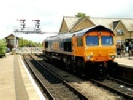Archive Section




An account of the lecture by Mr D. Marr esq. of Railtrack held on 13th April 1999, written by John Lunn
This meeting, perhaps predictably, had a rather poor turnout of just 14 members and two guests. However, this miss-
Mr. Marr spoke for about forty minutes, during which he gave a brief history of the document centres operated by the pre-
Much of the work carried out by the archive centre involves the filing and research plans, deeds, etc., which show the current and past ownership of what is now Railtrack, L.U.L., etc., property. Where associated new works (such as the Croydon Tramlink) take place, it enables study of what the relationship with Railtrack property is.
Mr. Marr had brought along a large box of documents, which he had put on display and then invited members to inspect the material and ask questions. There were many items of interest on display, the oldest of which was dated 1685 and was hand-
From Waterloo station was an inventory of a pub in York Road. The content of the pub, purchased by the L.S.W.R., was detailed room by room, from attic to cellar, and accounted for every item in the building, from chamber pots to beer glasses. As this document was dated 1898, I would assume it was purchased in connection with the station rebuilding, which commenced at that time.
There were also ledgers from the Stockton and Darlington Railway, the Highland and other Scottish railways, which recorded such things as the purchase of rails and locomotives, and deals with local suppliers of material.
The Great Western fans amongst us found documents concerning a Miss Talbot of Port Talbot Apparently the good lady owned land in the area and allowed the Great Western to build sidings -
There was a goad deal of other material on hand, which covered such things as the Metropolitan Railway, the railway grouping in 1923 and the Croydon Tramlink.
The work of this centre is ongoing, with documents covering works for the Channel Tunnel and the new high-